Related Research Articles

Sanskrit is a classical language belonging to the Indo-Aryan branch of the Indo-European languages. It arose in South Asia after its predecessor languages had diffused there from the northwest in the late Bronze Age. Sanskrit is the sacred language of Hinduism, the language of classical Hindu philosophy, and of historical texts of Buddhism and Jainism. It was a link language in ancient and medieval South Asia, and upon transmission of Hindu and Buddhist culture to Southeast Asia, East Asia and Central Asia in the early medieval era, it became a language of religion and high culture, and of the political elites in some of these regions. As a result, Sanskrit had a lasting effect on the languages of South Asia, Southeast Asia and East Asia, especially in their formal and learned vocabularies.

Vande Mataram is a poem written in Sanskrit and Sanskritised Bengali by Bankim Chandra Chatterjee in the 1870s. The first two verses of the poem were adopted as the National Song of India in October 1937 by the Congress.

Kālidāsa was a Classical Sanskrit author who is often considered ancient India's greatest poet and playwright. His plays and poetry are primarily based on Hindu Puranas and philosophy. His surviving works consist of three plays, two epic poems and two shorter poems.

Paneer, also known as panir, is a fresh acid-set cheese common in the cuisine of the Indian subcontinent made from full-fat buffalo milk or cow milk. It is a non-aged, non-melting soft cheese made by curdling milk with a fruit- or vegetable-derived acid, such as lemon juice.
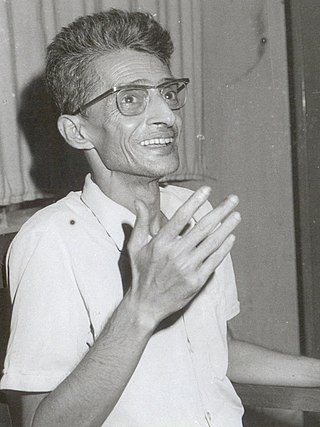
Charu Majumdar, popularly known as CM, was an Indian Communist leader, and founder and General Secretary of the Communist Party of India (Marxist-Leninist). Born into a progressive landlord family in Siliguri in 1918, he became a Communist during the Indian Independence Movement, and later formed the militant Naxalite cause. During this period, he authored the historic accounts of the 1967 Naxalbari uprising. His writings, particularly the Historic Eight Documents, have become part of the ideology which guides the insurgencies.

Hemachandra was a 12th century Indian Jain saint, scholar, poet, mathematician, philosopher, yogi, grammarian, law theorist, historian, lexicographer, rhetorician, logician, and prosodist. Noted as a prodigy by his contemporaries, he gained the title kalikālasarvajña, "the knower of all knowledge in his times" and father of the Gujarati language.
Stotra is a Sanskrit word that means "ode, eulogy or a hymn of praise." It is a literary genre of Indian religious texts designed to be melodically sung, in contrast to a shastra which is composed to be recited.
The yamas, and their complement, the niyamas, represent a series of "right living" or ethical rules within Yoga philosophy. The word yama means "reining in" or "control". They are restraints for proper conduct given in the Vedas and the Yoga Sutras as moral imperatives, commandments, rules or goals. The yamas are a "don't"s list of self-restraints, typically representing commitments that affect one's relations with others and self. The complementary niyamas represent the "do"s. Together yamas and niyamas are personal obligations to live well.
Sharma is a Hindu Brahmin surname. The Sanskrit stem ṣárman- can mean 'joyfulness', 'comfort', 'happiness'. Sarma and Sarmah are alternative English spellings of the name, commonly used by Assamese Brahmins.

Śrauta is a Sanskrit word that means "belonging to śruti", that is, anything based on the Vedas of Hinduism. It is an adjective and prefix for texts, ceremonies or person associated with śruti. The term, for example, refers to Brahmins who specialise in the śruti corpus of texts, and Śrauta Brahmin traditions in modern times can be seen in Kerala and Coastal Andhra.
Mithai (sweets) are the confectionery and desserts of the Indian subcontinent. Thousands of dedicated shops in India, Bangladesh, Nepal, Pakistan and Sri Lanka sell nothing but sweets.

Aamras is a sweet dish in the cuisine of the Indian subcontinent made from the pulp of the mango fruit. The pulp of a ripe mango is extracted, usually by hand, and is eaten together with pooris or chapatis, Indian breads. Sometimes ghee and milk are added to the pulp to enhance its flavour. Sugar may be added for sweetness. It is often eaten at celebrations and weddings with cardamon and chopped fruits.
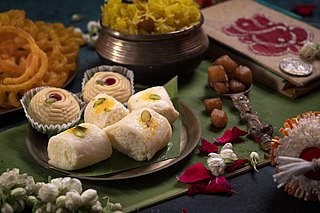
Sandesh is a dessert, originating from the Bengal region in the eastern part of the Indian subcontinent, created with milk and sugar. Some recipes of sandesh call for the use of chhena or paneer instead of milk itself. Some people in the region of Dhaka make a form of sandesh called pranahara which is softer and made with mawa and yogurt. The Gupo/Gufo style of sandesh from Guptipara is considered by some to be the "first branded sweet of Bengal".
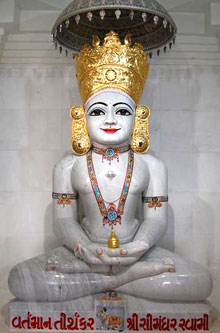
Mūrtipūjaka, also known as Derāvāsī ("temple-dweller") or Mandir Mārgī, is the largest sect of Śvetāmbara Jainism. Mūrtipūjaka Jains differ from both Śvetāmbara Sthānakavāsī and Śvetāmbara Terāpanthī Jains in that they worship images of the Tīrthaṅkaras. Mūrtipūjaka may also generally describe members of both the Śvetāmbara and Digambara traditions who use idols (mūrti) in their worship (pūjā).
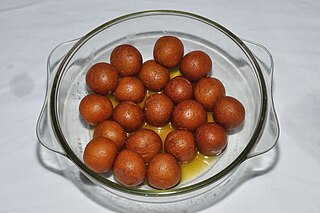
Pantua is a local confection from the Indian subcontinent, notable in West Bengal, Eastern India and Bangladesh. It is a traditional Bengali sweet made of deep-fried balls of semolina, chhena, milk, ghee and sugar syrup. Pantuas range in colour from pale brown to nearly black depending on how long they are fried. Rose water, cardamom or other flavourings are sometimes added to the sweet.

Ganesha, also spelled Ganesh, and also known as Ganapati, Vinayaka, and Pillaiyar, is one of the best-known and most worshipped deities in the Hindu pantheon and is the Supreme God in the Ganapatya sect. His depictions are found throughout India. Hindu denominations worship him regardless of affiliations. Devotion to Ganesha is widely diffused and extends to Jains and Buddhists and beyond India.
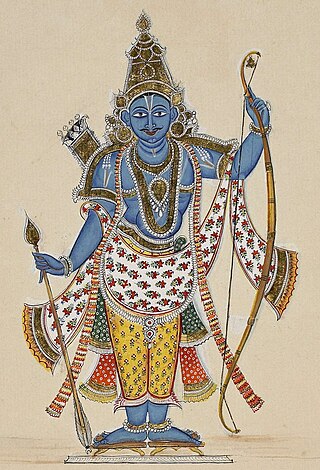
Rama is a major deity in Hinduism. He is the seventh and one of the most popular avatars of Vishnu. In Rama-centric traditions of Hinduism, he is considered the Supreme Being.
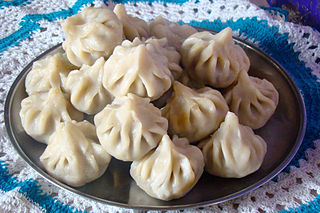
Modak (Marathi: मोदक) or Modakam (Sanskrit: मोदकम्), also referred to as Koḻukattai (கொழுக்கட்டை) in Tamil, is an Indian sweet dish popular in many Indian states and cultures. According to Hindu and Buddhist beliefs, it is one of the favourite dishes of Ganesha and the Buddha and is therefore used in prayers. The sweet filling inside a modak consists of freshly grated coconut and jaggery, while the outer soft shell is made from rice flour or wheat flour mixed with khowa or maida flour.

In Indian cuisine, dal, paruppu, or pappu are dried, split pulses that do not require soaking before cooking. India is the largest producer of pulses in the world. The term is also used for various soups prepared from these pulses. These pulses are among the most important staple foods in South Asian countries, and form an important part of the cuisines of the Indian subcontinent.
Persian astronomy or Iranian astronomy refers to the astronomy in ancient Persian history.
References
- ↑ Copson, Andrew; Grayling, A. C. (27 April 2015). The Wiley Blackwell Handbook of Humanism. John Wiley & Sons. p. 98. ISBN 978-1-118-79334-3.
- ↑ Kapoor, Subodh (2004). A Dictionary of Hinduism: Including Its Mythology, Religion, History, Literature, and Pantheon. Cosmo Publications. p. 87. ISBN 978-81-7755-874-6.